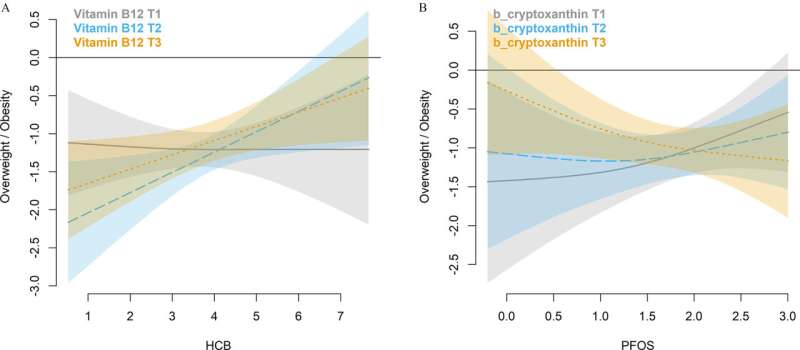This article has been reviewed according to Science X's editorial process and policies. Editors have highlighted the following attributes while ensuring the content's credibility:
fact-checked
peer-reviewed publication
trusted source
proofread
Associations between obesity and prenatal exposure to environmental pollutants vary depending on nutritional status

Prenatal exposure to persistent organic pollutants may contribute to the development of childhood obesity and metabolic disorders. However, the results of a study coordinated by ISGlobal, a research center supported by the "la Caixa" Foundation, and carried out in collaboration with France's National Research Institute for Agriculture, Food and Environment (INRAE), suggest that the nutritional status of the mother during pregancy may modulate these effects.
The authors of the study, published in Environmental Health Perspectives, found that high levels of vitamin B12 (found mainly in foods of animal origin, such as dairy products and meat, and in vitamin supplements) may enhance the obesogenic effect of prenatal exposure to the fungicide hexachlorobenzene. Conversely, the dietary antioxidant β-cryptoxanthin (found in many plant and animal foods, including oranges, apples and egg yolks) may have a protective effect against the obesogenic effects of perfluorooctane sulfonate (PFOS).
Contaminants and nutrients: Crucial interactions in prenatal development
There is a growing body of evidence that environmental insults and maternal nutrition during the early stages of development may influence subsequent health during childhood. For example, certain persistent organic pollutants that can bioaccumulate in fatty tissues have been associated with obesity and metabolic disturbances in childhood. These compounds, which may be ingested by the mother through her diet, include pollutants such as hexachlorobenzene and the pesticide known as DDT as well as its main metabolite, DDE.
The authors of this study wanted to look more closely at these interactions and to investigate the question of whether the health effects of persistent organic pollutants might be influenced by certain nutrients that share their uptake, transport and metabolism mechanisms or target similar molecular pathways. In short, they wanted to ascertain whether the effects of these pollutants could be modified by the lipophilic micronutrients, omega-3 or polyunsaturated fatty acids ingested in food.
To do this, they focused on the joint effect of persistent organic pollutants and these nutrients during the prenatal stage and their possible association with the risk of childhood obesity.
The joint effect in the development of childhood obesity
The study was based on data from the Spanish Environment and Childhood birth cohort (INMA—INfancia y Medio Ambiente) collected between 2003 and 2008. The analysis included data on persistent organic pollutants and specific nutrients in the blood of 1,394 women during the first trimester of pregnancy and anthropometric measurements of their children at seven years of age (40% of whom were overweight or obese).
They analyzed data on six organochlorine compounds and four per- and polyfluoroalkyl substances (better known as PFAS). The nutrients studied included vitamins (D, B12 and folate), polyunsaturated fatty acids and carotenoids.
"We observed that environmental pollutants and nutrients had a joint interaction effect on the risk of excess weight and obesity," explains Maribel Casas, who was an ISGlobal researcher at the time of the study and is the last author of the paper. "Based on our results, we can hypothesize that a high maternal intake of vitamin B12 in conjunction with a high exposure to hexachlorobenzene contributes to excess weight and obesity in childhood."
Another new observation was that, among children exposed in the womb to the highest levels of perfluorooctane sulfonates, the risk of obesity was higher in the infants whose mothers had lower levels of the antioxidant β-cryptoxanthin—a carotenoid.
"Further research is needed to confirm these findings and to gain a better understanding of the complex interactions between pollutants and nutrients during pregnancy and their effects on the child's metabolic programming," adds Germán Cano-Sancho, INRAE researcher and first author of the study. "The importance of this research is that it will help us to identify population subgroups vulnerable to persistent organic pollutants and establish more precise guidelines on nutrition and vitamin supplementation during pregnancy."
More information: German Cano-Sancho et al, Nutritional Modulation of Associations between Prenatal Exposure to Persistent Organic Pollutants and Childhood Obesity: A Prospective Cohort Study, Environmental Health Perspectives (2023). DOI: 10.1289/EHP11258




















